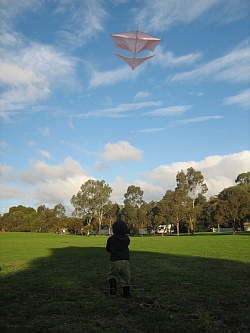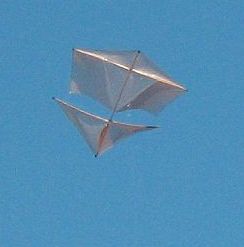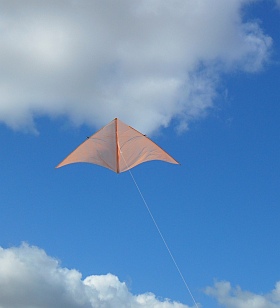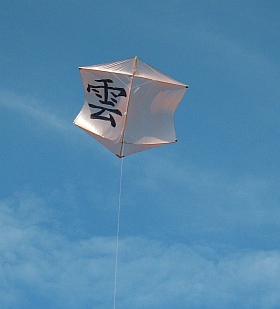- Home Page
- Simple Kites
- Why Make Your Own
Why Make Your own Kite?
Five Reasons!
With shop-bought designs so cheap, why make your own kite?
 Aren flies an MBK Dowel Roller
Aren flies an MBK Dowel RollerThere are plenty of rewards, including these top five. At least, just about all the experiences I have had with kites seem to fall into these categories!
The more often you make your own kite and fly it, the more discoveries await.
In a 21st-century world of high-tech devices, who would have thought that so much could be gained from something as simple as a single-line kite?
It's true that some can't appreciate single-line kiting, labeling it "boring." However, you're here reading this page so I don't think that applies to you!
In any case, very young kids almost always find the idea of flying a kite exciting after they first spot one flying high and steady!
There's my boy in the photo, flying a homemade roller—on a short line so I could fit everything in the frame.
On this site, there's more kite-making info than you can poke a stick at. :-)
Want to know the most convenient way of using it all?
The Big MBK E-book Bundle is a collection of downloads—printable PDF files which provide step-by-step instructions for many kites large and small.
That's every kite in every MBK series.
Make Your own Kite for
Building Pleasure
Some of us are just builders at heart. Can you remember getting into Mechano, Lego, or other building systems like that and really enjoying the creative process? While making a kite, you see a miniature aircraft taking shape before your eyes. The anticipation of flying builds as you approach the final steps.
 An MBK Dowel Roller hangs in light air
An MBK Dowel Roller hangs in light airPeople vary a lot when it comes to just how much complexity they are willing to cope with in a kite design!
At one end are the school teachers and mothers who just want a small and colorful kite that comes together in 15 minutes or less. As long as it rises up a little as a small child tows it around the backyard or other grassy area, they are happy. For the child, helping with decoration and attaching the tail can be rewarding. This is not to mention the huge buzz of seeing it actually fly outdoors!
At the other end of the building spectrum are the people who are talented and perhaps even professional artists and craftsmen. These creations look stunning and fly reliably over a wide wind-speed range. There are cellular kites, inflatables, whimsical artistic works, and others; the variety is breathtaking. Some of these high-end kites might take hundreds of hours to complete, including decoration.
But many of us are in the middle ground. We just want a kite that looks OK, flies high, flies reliably, and doesn't take too long to build! Is that you? If so, you'll make good use of my e-books!
A morning or afternoon on the weekend is enough time to set aside for making something that will return hours of enjoyment—as long as the wind strength is somewhere in the light-to-moderate range, which most of the time it is.
Make Your own Kite for
Flying Satisfaction
Let me briefly list four different types of flying that can be particularly fun to do with a single-line kite—like the homemade delta down there.
 Thermals a-plenty for an MBK Dowel Delta
Thermals a-plenty for an MBK Dowel Delta- Low-wind flying is a challenge. Occasionally, there will be barely enough wind to keep the kite up. Staying in the air will require constant attention to the kite. However, this can be fun when it happens! Stick at it and sharpen up your kite-handling skills. If you have few chances to fly, this will result in less disappointment.
- Confined-area flying can be a laugh from time to time! With a cheap expendable homemade kite, it's fun to attempt flying from a very small backyard, for example. The aim being to never actually let out enough line to lose the kite over the fence. On a larger scale, you might enjoy dicing with danger down at a small park, where tall trees are liable to reach out and grab your kite. The keys to this kind of flying are quick reel-ins and quick sideways running to head off disaster! Just getting the kite in the air at all will require timing. Wait for that next gust!
- High-altitude flying is satisfying, although I am careful to stay below the legal limit of 120 meters (400 feet) here in South Australia. Still that's high enough to enjoy seeing your own flying creation floating about so removed from the ground-level existence we experience most of the time. One day I would love to get into China, where apparently you can fly kites as high as you like just about anywhere!
- Thermal flying is a buzz with light-wind kites. Thermals are patches of rising air that occur due to uneven heating of the ground. Soaring birds such as eagles and hawks use them all the time to avoid having to flap their wings. As an ex–soaring pilot myself, I used to think thermals were very big and quite rare in cool weather. However, kite flying has taught me that small patches of rising air occur practically everywhere, nearly all of the time that there is any direct sunlight at all. If you make your own kite that is light enough, it's possible to tow it into rising air on an almost-calm day and watch it get gently lofted overhead in a passing thermal! Often, the effect of rising air on your kite is more subtle, and it takes practice to recognize and exploit it.
Make Your own Kite for
Family Fun
With all the modern emphasis on beach kites and kite flying for kids, this aspect is pretty well known. It's not just fun for kids, since the whole family can get involved.
Making the kites at home provides an added dimension to the experience for kids, since they can get involved in the simpler aspects of construction. For example, as already mentioned on this page, they can try doing simple decoration and adding tails. It's satisfying for them to see their own efforts up there in the air.
With a mid-sized kite, a wide age-range can take part in the
flying. Picking light-wind weather to fly in also helps here, since the
pull on the line is more gentle. We had our 3-year-old son hanging onto a
1.2 meter (4 feet) span rokkaku one time! It was just to get a photo of
him, and the wind was very light. There's the rok in the photo below.
On another occasion, we had him flying a small box kite. However, the wind was in the fresh-to-strong range, and the little fellow struggled to hang on! By the way, if you want to make your own kite, deltas are known for their relatively light pull for any given size of kite.
Unless there is a lot of room to spread out, it's probably more practical for a small family to share a single kite when going out to fly.
Sky Knowledge
 My Dowel Rokkaku says "clouds"
My Dowel Rokkaku says "clouds"It just happens, if you make your own kite and fly it often enough! You learn stuff you never intended to learn.
Here's a list of just some of these things:
- knowing when you have two minutes to get the kite down before rain hits
- knowing that the wind will moderate when that low dark patch of cloud scoots away
- judging wind strength from leaf noise and branch waving
- realizing that most local bird species have a level of curiosity about your kites and often fly in closer for a look!
- realizing that when you make your own kite, there are probably a dozen or more possible reasons why it wants to loop left or right when wind gusts get too strong
And so on. There's no end to it!
Educational Aspects
This is not the place to go into aerodynamics or physics in any depth, but you might be interested in these few general points.
The simplicity of kite flight is an illusion! To fully explain or simulate the flight of a simple single-line kite is actually a big task. It's a "glider on a string" with the tethered aspect providing all sorts of extra complications. But it's not necessary to consider this fact at all in order to enjoy single-line kiting. Any twit can hang onto a kite line :-)
Many schools include kite studies to help teach very basic aerodynamics and physics to the students. With the practical side of kite making and flying easily within reach of even young teenagers, it's a fun and engaging way to pass on knowledge.
Even without formal studies, making and flying kites will teach you more and more about why and how things fly. Get out there and make your own kite!
As mentioned earlier, there's more kite making on this site than you can poke a stick at. :-)
Want to know the most convenient way of using it all?
The Big MBK E-book Bundle is a collection of downloads—printable PDF files which provide step-by-step instructions for many kites large and small.
That's every kite in every MBK series.
